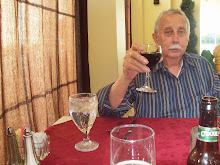I thought maybe some of you might be interested in how my Morgaine Series of novels became a series. It started with a song, Dancing in the Moonlight. When I heard that song, I pictured Wiccans or some other new age group in a meadow in the forest having some sort of ritual. I thought, Suppose an ordinary person became somehow involved with such a group by fate, not by choice. So I created Melody Trent, a young widow, who falls in love with a psychic, Michael Ellul. But, who is this Michael? I decided to make him a thousand year old sorcerer who had been granted this extended life by a demon. I figured that Melody should have a rival for Michael's affection, so I created Morgaine Fabiano, a witch. I threw in some other complications such as Isaac the robot and soon I had a novel, which I titled Dancing in the Moonlight.
When I found a publisher for it, it was an E-book publisher, Renaissance E-Books. The publisher thought it was too long for an E-book. She wanted me to split it into two novels, which I did. They became the first two novels in the series, Morgaine and Michael, and Morgaine and Melody.
I was not quite satisfied with the ending. I thought to myself, What is going to happen when Melody ages and Michael remains youthful? It seems like he would disappear from her life after a while. Perhaps he would seek a means to restore her youth so that she would remain his lover and companion through the long centuries. And what would Melody do when he disappears? Hunt for him, of course. Well, she couldn't do this herself, so she hires Raven Lenore, a tough PI and Wiccan (a witch to catch a wizard). And of course, Morgaine has to fit into the story somehow. She returns as demon in order to somehow regain the love of Michael. Mix in a megalomaniac out to steal Michael's robot, and viola, you have Morgaine and Raven, a suspense thriller.
In the next novel, I told the story of how Morgaine became a witch, and how she met Michael for the first and second times, and from her point of view, why she did the things she did. Alas, this also turned out to be too long and had to be split into two books, Morgaine and Gretchen, and Morgaine and Asmodeus.
As a writer of science-fiction and fantasy, one of the things that's great fun to write about is the end of the world. I used the Book of Revelations of the Bible as a sort of outline plus some stuff from the internet about Armageddon, included the possibility of earth being struck by a gigantic meteorite, threw in Frankenstein, Dracula and various demons, bad guys, aliens and other strange characters. And of course the schemes of Morgaine played a big part. This weird mix became Morgaine and Armageddon.
At that point, I thought I was done with Morgaine and company. But then I thought, With all the strange things that had happened at Moonwood (Michael's mansion in the country), it would make a great background for a haunted house story. So I invented two new characters, a young engaged couple, Tom and Bridget, who were hired as contractors to repair the mansion. Of course, Morgaine and various demons and ghosts make life at Moonwood hell for the couple. I called this book Morgaine and Moonwood. My sequal to this is what happens after Bridget has the baby that she conceived when she was raped by the demon Asmodeus. This was to be the final book of the series and is called Morgaine and Nicholas. Since then, I've added two more novels to the series, Morgaine and the Necromancer and Morgaine and the Sorcerer's Guild.


